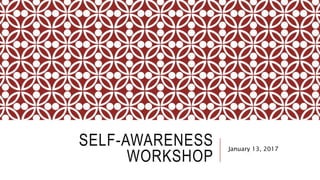11869841.ppt
- 2. INTRODUCTIONS Introduce yourself – name, background, global interests, something interesting about you… Tell us something why someone would want to be on a team with you?
- 3. THE KEY TO SELF MANAGEMENT Portrait of a Self-Managed Person The Whole Person Self-Confidence Self-Awareness Drive Self-Respect/ Self-Esteem Emotional Intelligence
- 4. SELF-AWARENESS  Who am I?  How do I behave?  How do I see myself?  How do others see me?
- 5. IMPORTANCE OF SELF- AWARENESS Ability to understand and reflect on self and others without bias Ability to self-monitor Ability to manage impressions
- 6. SELF AWARENESS QUESTIONNAIRES Answer and Score My self estimation and my leadership style
- 7. SELF ESTEEM Value of oneself Derived from life experiences and internalized self-concept Self esteem impacts job performance, leadership and risk-taking
- 8. THE MANAGERIAL GRID Prentice Hall, 2002
- 9. WHAT IS THE JOHARI WINDOW? The Johari Window is a communication model that can be used to improve understanding between individuals. Developed by Joseph Luft and Harry Ingham (the word “Johari” comes from Joseph Luft and Harry Ingham).
- 10. TWO KEY IDEAS BEHIND THE TOOL: Individuals can build trust between themselves by disclosing information about themselves. They can learn about themselves and come to terms with personal issues with the help of feedback from others.
- 11. HOW DOES IT WORK? Using the Johari model, each person is represented by their own four-quadrant, or four-pane, window. Each of these contains and represents personal information - feelings, motivation - about the person, and shows whether the information is known or not known by themselves or other people.
- 13. THE FOUR QUADRANTS ARE: Quadrant 1: Open Area  What is known by the person about him/herself and is also known by others.
- 14. Quadrant 2: Blind Area, or "Blind Spot"  What is unknown by the person about him/herself but which others know.  This can be simple information, or can involve deep issues (for example, feelings of inadequacy, incompetence, unworthiness, rejection) which are difficult for individuals to face directly, and yet can be seen by others.
- 15. Quadrant 3: Hidden or Avoided Area  What the person knows about him/herself that others do not.
- 16. Quadrant 4: Unknown Area  What is unknown by the person about him/herself and is also unknown by others.
- 19. EXERCISE: SELF-CONFIDENCE My Strengths Things I can’t change about me Challenges to my self-confidence Barriers to change Group discussion – discuss strengths and challenges Action Plan
- 20. SURVIVAL OF YOUR TEAM! You and your companions have just survived the crash of a small plane. Both the pilot and co-pilot were killed in the crash. It is mid-January , and you are in Northern Canada. The daily temperature is 25 below zero, and the night time temperature is 40 below zero. There is snow on the ground, and the countryside is wooded with several creeks criss-crossing the area. The nearest town is 20 miles away. You are all dressed in city clothes appropriate for a business meeting. Your group of survivors managed to salvage the following items: A ball of steel wool A small ax A loaded .45-caliber pistol Can of Crisco shortening Newspapers (one per person) Cigarette lighter (without fluid) Extra shirt and pants for each survivor 20 x 20 ft. piece of heavy-duty canvas A sectional air map made of plastic One quart of 100-proof whiskey A compass Family-size chocolate bars (one per person) Please discuss what you would need as a group and rank order your choices
- 22. GROUP PROCESSES: REFLECT ON THE GROUP ÔÇßEstablishing the goals ÔÇßHow to get the tasks done ÔÇßHow to work with large amounts of data ÔÇßConsensus building ÔÇßClosure and Summary for group ÔÇßWhat roles did each of us play?
- 23. OUR INDIVIDUAL JOURNEY FROM HERE… What can we take from here… Awareness Changes we want to make in ourselves Goals and action plans Constant introspection, interpretation and strive for effectiveness






















